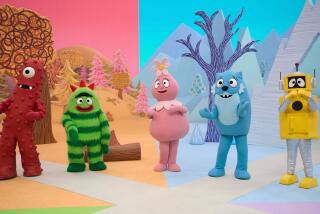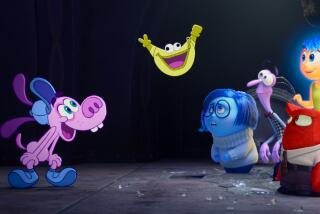Even now, Gumby has that special dimension
GUMBY, the little green clay boy, is celebrating 50 years in show business this year -- it was in 1956 that he made his first appearance on television, on “The Howdy Doody Show” -- and he’s looking as young as ever. There’s not a wrinkle on him, and if there were, you could just smooth it out with your thumb.
It has been a long time since I’ve thought much about Gumby -- and Pokey too, of course, his pony pal. But he has never really left my head. He is parked back there, in one of his sporty toy cars, with the other authentically strange, even disturbing things of childhood. Not that Gumby himself was particularly disturbing, in spite of being a naked slab of green clay with a lopsided head and bell-bottomed legs with indentations where his feet should be. But disturbing things happened to him -- he was attacked and eaten by baked goods, for instance -- that were the stuff of nightmares. Watching that episode again recently (“In the Dough”), I see that I was not mistaken. I was not just being a baby. It’s scary stuff.
Well, it’s not all scary stuff. But even when it’s cute, it’s strange.
All animation is a kind of magic act, of course, but clay or puppet animation has a special power in that its subjects are real -- that is, three-dimensional objects that inhabit a world of substance and shadow, a place of actual, not computer-rendered depth. Even on the flattened screen, we can tell the difference. When Gumby puts on a cowboy hat, or it is put on him, it really is on him. When you buy a Gumby doll, you are not buying some weird hypothetical extrusion of a flat figure into real space, like a Homer Simpson figurine, but a proportionate replica of the thing itself.
Of clay and staying power
ART CLOKEY, the man who made Gumby, was far from the first to breathe life into inanimate objects frame by frame, but without a doubt, Clokey created the first clay TV star and one whose staying power and range of influence have exceeded that of such contemporaries as Howdy Doody, Huckleberry Hound or Cecil the Seasick Sea Serpent. (Gumby has legs, even if he doesn’t have feet.) Now the creator and his creations are being honored this summer at the Museum of Television & Radio in Beverly Hills in “First of the International Clayboys: Gumby and the Animation Legacy of Art Clokey.” Running through Sept. 10, it includes a selection of “Gumby” shorts from the museum’s collection along with some of Clokey’s religious series “Davey and Goliath” (produced in conjunction with the Lutheran Church from 1960 to 1975 and currently parodied on Cartoon Network’s “Moral Orel”) and odds and ends including animated abstractions and ad work.
There are two kinds of genius in this world, the imitable and the inimitable. “Gumby” is a work of the second sort, the thing that is so completely, singularly itself, so far off down its own road, so unpredictable and odd, bizarrely constituted and eccentrically executed that there’s nowhere for anyone else to take it, no variations to play on the theme. He is original and inarguable, and though he has gone in and out of fashion, been parodied and abused -- check out Youtube.com to view some not-for-children unsanctioned adventures -- whatever insults have been done him are only further testament to his iconic power. Eddie Murphy’s “I’m Gumby, dammit” is funny only if you already know Gumby.
Everything about the show is, appropriately, elastic. Gumby is officially 7 inches tall, but he is as big or small as he needs to be; his relative scale changes sometimes even within a scene. He might be bigger than a lion or smaller than a rabbit. He sometimes seems to live in a toy store, although he also lives in a house with his parents, Gumbo -- who looks like a Pokey-colored Gumby wearing a clay toupee -- and Gumba. (Later he gained a little sister, Minga.) He’s smaller than the books into whose covers he melts to visit the worlds inside them -- the Old West, the Kingdom of Roo, the jungle -- where he seems to inhabit a human world on human scale and to interact with characters who, though they are also clearly made of clay, are not, like Gumby, actually supposed to be made of clay.
Details -- who needs ‘em?
THE scripts have the feeling of having been written all at a gallop, of having been scribbled down after a dream or improvised over a bowl of cornflakes without worrying too much about what does or doesn’t make sense. Gumby stories start fast, with minimal explanation. Gumby is selling watermelons to buy his mother a special birthday present; a man sells him a potion that turns them into little gremlins. Gumby and Pokey are on vacation with $100. (Where did they get $100?) Gumby and Pokey run away from home into space, where they happen upon three small planets each run by an antisocial child.
Sometimes they just wander around playing with toys. Once in a while an episode might try to teach a small lesson -- ask permission before doing anything you should ask permission to do, stuff like that -- but they aren’t really out to make any sort of moral point. For one thing, Gumby, though sometimes haplessly impulsive, is too good a person (or whatever he is) to ever need much correction, and Pokey is by nature cautious and conservative, although he did eat the super-powered chicken food after Gumby told him not to and grew twice as tall as a house.
“I wouldn’t if I were you,” is a typical Pokeyism. Or, “I’m not scared -- I just don’t like it.” Or, “I’m all for adventure, but this is suicide.”
Pokey has horse sense, but no practical knowledge. Gumby knows a thing or two about this and that -- that “morph” is a Greek word meaning “change,” that a raindrop starts as a speck of dust -- and he can hatch a plot to save a princess or to get his money back from the Blockheads. But he runs on guileless enthusiasm, lacks foresight, and is easy to trick.
Gumby’s own lack of sophistication is reflected in the show’s production standards. Compared to the similar work of Will Vinton, Nick Park and Henry Selick, the sets and figures are rough-hewn and obviously handmade, while the dialogue -- Clokey himself voiced Pokey much of the time -- is often delivered in a strangely halting manner that can sound something less than professional. The earliest episodes -- the show was in production in the late ‘50s, intermittently through the ‘60s and again in the late ‘80s, and an independently financed film was released in 1995 -- are almost laughably crude, like a kid’s school project, though even the later, slicker episodes retain some of their antique handmade charm.
This is also what makes “Gumby” great: Its seams show, which puts it out of step with a time when animation is busy ridding itself of any evidence of a human hand. It makes the whole production seem oddly poetic. As much as something that is made frame by frame can exhibit a lack of calculation, “Gumby” does.
And it is clearly a work of vision: Clokey, who studied film with famed montage artist Slavko Vorkapich and also spent a year in a seminary studying to become an Episcopal priest, has spoken of “Gumby” both in art-theoretical and spiritual terms. “Gumby is a symbol of the spark of divinity in each of us, the basis of the ultimate value of each person.”
But it’s a vision transformed into something richer by the filmmaker’s technical limitations and Gumby-like naivete. However weird it gets, “Gumby” never seems contrived: Like good folk art, it is firmly rooted in this world and another, doing business with the real and surreal, with a reach greater than its grasp.
More to Read
The complete guide to home viewing
Get Screen Gab for everything about the TV shows and streaming movies everyone’s talking about.
You may occasionally receive promotional content from the Los Angeles Times.







